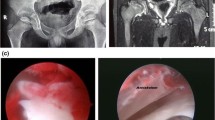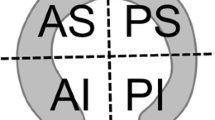Abstract
The assessment of a patient with chronic hip pain can be challenging. The differential diagnosis of intra-articular pathology causing hip pain can be diverse. These includes conditions such as osteoarthritis, fracture, and avascular necrosis, synovitis, loose bodies, labral tears, articular pathology and, femoro-acetabular impingement. Magnetic resonance imaging (MRI) arthrography of the hip has been widely used now for diagnosis of articular pathology of the hip. A retrospective analysis of 113 patients who had MRI arthrogram and who underwent hip arthroscopy was included in the study. The MRI arthrogram was performed using gadolinium injection and reported by a single radiologist. The findings were then compared to that found on arthroscopy. The sensitivity, specificity, positive predictive value (PPV), negative predictive value (NPV), accuracy and 95% confidence interval were calculated for each pathology. Labral tear—sensitivity 84% (74.3–90.5), specificity 64% (40.7–82.8), PPV 91% (82.1–95.8), NPV 48% (29.5–67.5), accuracy 80%. Delamination —sensitivity 7% (0.8–22.1), specificity 98% (91.6–99.7), PPV 50% (6.8–93.2), NPV 74% (65.1–82.2) and accuracy 39%. Chondral changes—sensitivity 25% (13.3–38.9), specificity 83% (71.3–91.1), PPV 52% (30.6–73.2), NPV 59% (48.0–69.2) and accuracy 58%. Femoro-acetabular impingement (CAM deformity)—sensitivity 34% (19.6–51.4), specificity 83% (72.2–90.4), PPV 50% (29.9–70.1), NPV 71% (60.6–80.5) and accuracy 66%. Synovitis—sensitivity 11% (2.3–28.2), specificity 99% (93.6–100), PPV 75% (19.4–99.4), NPV 77% (68.1–84.6) and accuracy 77%. Our study conclusions are MRI arthrogram is a useful investigation tool in detecting labral tears, it is also helpful in the diagnosis of femoro-acetabular impingement. However, when it comes to the diagnosis of chondral changes, defects and cartilage delamination, the sensitivity and accuracy are low.






Similar content being viewed by others
References
Feeley B, Powell J, Muller M, Barnes R, Warren R, Kelly B (2008) Hip injuries and labral tears in the national football league. Am J Sports Med 36:2187–2195
Edwards DJ, Lomas D, Villar RN (1995) Diagnosis of the painful hip by magnetic resonance imaging and arthroscopy. J Bone J Surg 77B:374–376
Czerny C, Hofmann S, Neuhold A, Tschauner C, Engel A, Recht MP, Kramer J (1996) Lesions of the acetabular labrum: accuracy of MR imaging and MR arthrography in detection and staging. Radiology 200:225–230
Schmid MR, Notzli HP, Zanetti M, Wyss TF, Hodler J (2003) Cartilage lesions in the hip: diagnostic effectiveness of MR arthrography. Radiology 226:382–386
Petersilge CA (2001) MR arthrography for evaluation of the acetabular labrum. Skelet Radiol 30(8):423–430
Lubowitz JH, Poehling GG (2006) Hip arthroscopy: an emerging gold standard. Arthroscopy 22(12):1257–1259
Baber YF, Robinson AHN, Villar RN (1999) Is diagnostic arthroscopy of the hip worthwhile? A prospective review of 328 adults investigated for hip pain. J Bone J Surg 81B:600–603
O`Leary JA, Berend K, Vail TP (2001) The relationship between diagnosis and outcome in arthroscopy of the hip. Arthroscopy 17:181–188
Clement ND, MacDonald D, Gaston P (2014) Hip arthroscopy for femoroacetabular impingement: a health economic analysis. Hip Int 24(5):457–464
Locher S, Werlen S, Leunig M, Ganz R (2002) MR-Arthrography with radial sequences for visualization of early hip pathology not visible on plain radiographs. [Article in German]. Z Orthop Ihre Grenzgeb 140(1):52–57
Zlatkin MB, Pevsner D, Sanders TG, Hancock CR, Ceballos CE, Herrera MF (2010) Acetabular labral tears and cartilage lesions of the hip: indirect MR arthrographic correlation with arthroscopy—a preliminary study. AJR Am J Roentgenol 194(3):709–714
Byrd JW, Jones KS (2004) Diagnostic accuracy of clinical assessment, magnetic resonance imaging, magnetic resonance arthrography, and intra-articular injection in hip arthroscopy patients. Am J Sports Med 32(7):1668–1674
Chan YS, Lien LC, Hsu HL, Wan YL, Lee MS, Hsu KY, Shih CH (2005) Evaluating hip labral tears using magnetic resonance arthrography: a prospective study comparing hip arthroscopy and magnetic resonance arthrography diagnosis. Arthroscopy 21:1250
Keeney JA, Peelle MW, Jackson J, Rubin D, Maloney WJ, Clohisy JC (2004) Magnetic resonance arthrography versus arthroscopy in the evaluation of articular hip pathology. Clin Orthop Relat Res 429:163–169
Smith TO, Hilton G, Toms AP, Donell ST, Hing CB (2011) The diagnostic accuracy of acetabular labral tears using magnetic resonance imaging and magnetic resonance arthrography: a meta-analysis. Eur Radiol 21:863–874
Pfirrmann CW, Duc SR, Zanetti M, Dora C, Hodler J (2008) MR arthrography of acetabular cartilage delamination in femoroacetabular cam impingement. Radiology 249:236–241
Anderson LA, Peters CL, Park BB, Stoddard GJ, Erickson JA, Crim JR (2009) Acetabular cartilage delamination in femoroacetabular impingement: risk factors and magnetic resonance imaging diagnosis. J Bone Joint Surg Am 91:305–331
Smith TO, Simpson M, Ejindu V, Hing CB (2013) The diagnostic test accuracy of magnetic resonance imaging, magnetic resonance arthrography and computer tomography in the detection of chondral lesions of the hip. Eur J Orthop Surg Traumatol 23:335–344
Mintz DN, Hooper T, Connell D, Buly R, Padgett DE, Potter HG (2005) Magnetic resonance imaging of the hip: detection of labral and chondral abnormalities using noncontrast imaging. Arthroscopy 21:385–393
Anderson LA, Peters CL, Park BB, Stoddard GJ, Erickson JA, Crim JR (2009) Acetabular cartilage delamination in femoroacetabular impingement. Risk factors and magnetic resonance imaging diagnosis. J Bone Joint Surg Am 91:305–313
Ganz R, Parvizi J, Beck M, Leunig M, Notzli H, Siebenrock KA (2003) Femoroacetabular impingement: a cause for osteoarthritis of the hip. Clin Orthop Relat Res 417:112–120
Notzli HP, Wyss TF, Stoecklin CH, Schmid MR, Treiber K, Hodler J (2002) The contour of the femoral head–neck junction as a predictor for the risk of anterior impingement. J Bone Joint Surg Br 84:556–560
Aprato A, Masse A, Faletti C, Valente A, Atzori F, Stratta M, Jayasekera N (2013) Magnetic resonance arthrography for femoroacetabular impingement surgery: is it reliable? J Orthopaed Traumatol 14:201–206
Newberg AH, Newman JS (2003) Imaging the painful hip. Clin Orthop Relat Res 406:19–28
Krebs VE (2003) The role of hip arthroscopy in the treatment of synovial disorders and loose bodies. Clin Orthop Relat Res 406:48–59
Milgram JW (1977) The classification of loose bodies in human joints. Clin Orthop Relat Res 124:282–291
Milgram JW (1977) The development of loose bodies in human joints. Clin Orthop Relat Res 124:292–303
Rai NN, Siney PD, Fleming PA, Wroblewski BM (2001) Incidence of loose bodies in an osteoarthritic hip. J R Coll Surg Edinb 46:274–276
Neckers AC, Polster JM, Winalski CS, Krebs VE, Sundaram M (2007) Comparison of MR arthrography with arthroscopy of the hip for the assessment of intra-articular loose bodies. Skelet Radiol 36(10):963–967
Aprato A, Jayasekera N, Villar RN (2013) The accuracy of magnetic resonance arthrography in hip arthroscopic labral revision surgery. Hip Int 23(1):99–103
Reurink G, Jansen SP, Bisselink JM, Vincken PW, Weir A, Moen MH (2012) Reliability and validity of diagnosing acetabular labral lesions with magnetic resonance arthrography. J Bone Joint Surg Am 94(18):1643–1648
Crespo Rodríguez AM, de Lucas Villarrubia JC, Pastrana Ledesma MA, Millán Santos I, Padrón M (2015) Diagnosis of lesions of the acetabular labrum, of the labral-chondral transition zone, and of the cartilage in femoroacetabular impingement: correlation between direct magnetic resonance arthrography and hip arthroscopy. Radiologia 57(2):131–141
Author information
Authors and Affiliations
Corresponding author
Ethics declarations
Conflict of interest
The authors declare that they have no competing interests.
Rights and permissions
About this article
Cite this article
Rajeev, A., Tuinebreijer, W., Mohamed, A. et al. The validity and accuracy of MRI arthrogram in the assessment of painful articular disorders of the hip. Eur J Orthop Surg Traumatol 28, 71–77 (2018). https://doi.org/10.1007/s00590-017-2022-9
Received:
Accepted:
Published:
Issue Date:
DOI: https://doi.org/10.1007/s00590-017-2022-9




